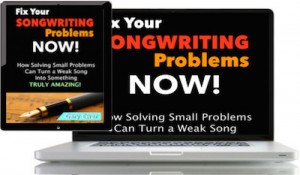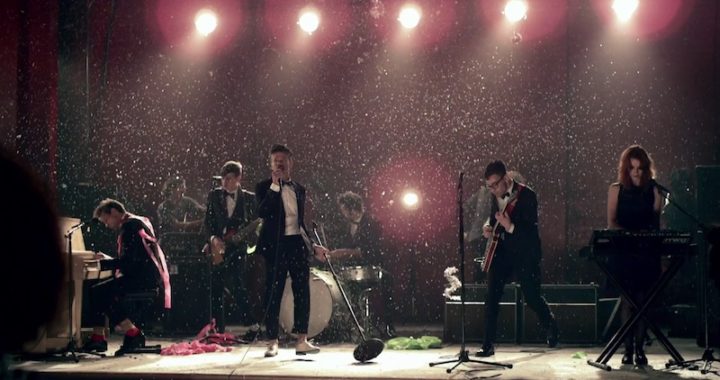Most songs consist of several sections, such as verse, chorus, bridge, etc. When we talk about or analyze those various sections, we’re talking about a song’s form. One of the most common forms in popular songwriting genres is the verse-chorus format, with all of its many possible variations.
 Who knows how many possible problems or errors that can be committed when writing a song? Of the hundreds of possible pitfalls, here are the seven most common ones, with solutions you can try: Fix Your Songwriting Problems – NOW!
Who knows how many possible problems or errors that can be committed when writing a song? Of the hundreds of possible pitfalls, here are the seven most common ones, with solutions you can try: Fix Your Songwriting Problems – NOW!
When you look at all the different sections that make up a song’s form, you’re usually considering whether or not:
- a section’s melody gets repeated with the same lyrics (e.g., the chorus;)
- a section’s melody gets repeated with different lyrics (e.g., the verse;)
- you encounter a new section that features a new melody with new lyrics (e.g., a bridge)
In this blog post I’m going to suggest ways that you can break free or abandon the notion of sticking to a standard song form, but it begs the question: Why would you want to consider that? What’s wrong with sticking to a standard song form?
The short answer is: nothing. Adhering to a standard song format isn’t typically a problem. But if you’re looking for ways to make your songwriting a bit more creative, creating a kind of ad hoc song form can be an important part of designing a unique listening experience for your listeners.
The Purpose of Song Form
Why did music evolve this way, so that most songs are compartmentalized into a standard format like the verse-chorus form? Standard song forms do three main things for the audience:
- They provide a repeating lyric (the chorus) that summarizes the essential elements of the song, which tells the audience what the song is about.
- They provide a way to continue a narrative and add to the basic story (the verse).
- They provide optional sections that either add musical interest or allow for a lyric to expand beyond what’s usually available in the verse or chorus (the bridge and other miscellaneous sections).
But song form does one other important thing: it allows the emotional energy of the song to ebb and flow. Take a classic hit song like James Taylor’s “Fire and Rain.” Compare the verse and chorus lyric. The verses set the stage, at times telling a story, and at times simply describing a situation. The chorus gives a summing up — a kind of summary of the singer’s state of mind.
And hand-in-hand with the lyric is the placement of the melody — sometimes low, sometimes high — all meant to help carefully contour the emotional energy of the song. The verse melody tends to sit low in the voice, pulling the listener in and creating interest. The chorus melody soars higher, allowing emotion to build.
And that is probably a song form’s most important job: to allow emotions to ebb and flow. And practically every song in the verse-chorus format, regardless of when it was written, does this: “Locked Out of Heaven” (Bruno Mars, Philip Lawrence, Ari Levine).
Other songs emphasis the rhythmic strength and solidity of the chorus, like we hear in a song like Kelly Clarkson’s “Mr. Know It All” (Brian Seals, Ester Dean, Brett James, Dante Jones).
The verse and chorus reside in mainly the same range, so there’s not so much chance for a build up of emotional energy by raising the chorus pitch. But the rhythm switches from lots of quick, busy interactions between voice and melody, to something much more solid and hook-like in the chorus.
Going Beyond Verse-Chorus
So if verse-chorus song formats are so good at that all-important ebb and flow of emotional energy, why should you experiment with breaking free from it?
The main reason is to allow you to create a unique design for your song that doesn’t mimic the formats that have been used by so many other songs. Finding other ways to allow musical energy to ebb and flow can set your songs apart from others, and create a unique musical experience for your audience.
What are the ways you can break free? Here are some ideas:
- Rearrange standard song sections. Try starting with the chorus, with an instrumental solo, an extended instrumental intro, or anything else that takes you away from what your typical audiences might expect. Example: Dire Strait’s “Money For Nothing.”
- Change section tempos. The energy we perceive from music is often enhanced by tempo choice. So you might try writing a song where the audience gets to hear different tempos as the song progresses. (Example: “We Are Young” (F.U.N. ft Janelle Monaé, written by Nate Ruess, Andrew Dost, Jack Antonoff and Jeffrey Bhasker)
- Sectionalize without verse-chorus. This was a standard idea in the prog rock days (“Cinema Show” – Genesis), but there’s no particular reason that you can’t use that idea today. Simply create sections, each of which has a distinct beginning and ending, all of which move smoothly one to the next.
In choosing simply to create successive song sections, as suggested above, you don’t particularly worry about which section might be heard as a verse or chorus. But you still need to think about the ebb and flow of emotional energy.
So by rearranging your music, or by creating miscellaneous unlabeled sections, you can create a unique experience for your listeners that will still captivate and draw them in as much as the verse-chorus format does, as long as you offer a rise and fall of emotion.
When it comes down to it, that’s what listeners are trying to pull out of your song — emotion.
My advice to songwriters is to use your imagination when considering how to assemble the sections of your songs, always considering the ups and downs of emotional energy as the main design feature.
 Written by Gary Ewer. Follow Gary on Twitter.
Written by Gary Ewer. Follow Gary on Twitter.
 Are you wondering how you can take your chord progressions beyond the basic I-IV-V-I ones you’ve been stuck using? “Creative Chord Progressions” shows you how. Right now, it’s being offered FREE with your purchase of “The Essential Secrets of Songwriting 10-eBook Bundle.” (Or purchase it separately.)
Are you wondering how you can take your chord progressions beyond the basic I-IV-V-I ones you’ve been stuck using? “Creative Chord Progressions” shows you how. Right now, it’s being offered FREE with your purchase of “The Essential Secrets of Songwriting 10-eBook Bundle.” (Or purchase it separately.)











Excellent advice! Also if songs use a lot of “parallel construction” (repeating parts of phrases or entire phrases), choruses aren’t necessary to drive home the theme of the song. Examples:
The Beatles – Hey Jude
Billie Holiday – How Deep Is the Ocean
Howlin Wolf – Spoonful
Bob Dylan – A Hard Rain’s A-Gonna Fall (also a whole handful of his other songs)
Leonard Cohen – Who By Fire
Leonard Cohen – Bird On The Wire
Simon and Garfunkel – Bridge Over Troubled Water